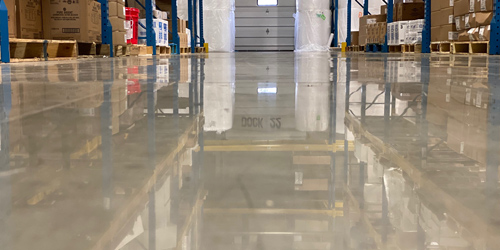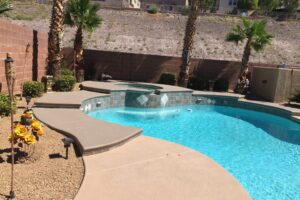Concrete polishing is a transformative process that elevates ordinary concrete into a sleek, durable, and sophisticated surface. This technique has gained popularity in both residential and commercial spaces, offering a versatile and long-lasting alternative to traditional flooring. In this comprehensive guide, we explore the process, costs, benefits, and essential equipment involved in concrete polishing, helping you decide if this finish is the right choice for your space.
What is Concrete Polishing, and How is it Done?
Concrete polishing is a multi-step process that involves grinding down the surface of a concrete floor to create a smooth, glossy finish. Unlike traditional concrete coatings, polished concrete relies on the refinement of the concrete surface itself, rather than adding a top layer. The process requires specialized equipment and a systematic approach to achieve a high-gloss, mirror-like finish.
Steps Involved in Concrete Polishing:
- Surface Preparation – Before polishing, the floor must be cleaned and any existing coatings or sealants removed. This ensures that the concrete surface is bare and ready for refinement.
- Grinding – The initial stages of concrete polishing involve grinding the floor with coarse diamond segments. This step removes minor imperfections, levels the floor, and opens the concrete’s pores for better refinement.
- Honing – After grinding, the surface is honed with progressively finer diamond abrasives. Honing smooths the concrete further and prepares it for the polishing phase.
- Polishing – The polishing stage uses finer grits of diamond segments to bring out the floor’s natural luster, creating a smooth, reflective finish.
- Sealing – A penetrating sealer is applied to protect the polished surface from stains and moisture, enhancing durability without affecting the floor’s natural shine.
Polishing concrete requires precision and expertise, as each stage of the process builds on the previous one. The result is a resilient, low-maintenance floor with a unique, lustrous look.
Benefits of Concrete Polishing
Concrete polishing offers an array of advantages, making it a highly desirable option for both residential and commercial spaces. Here are some of the key benefits:
- Enhanced Durability and Longevity
Polished concrete is highly durable and resistant to wear, making it suitable for areas with heavy foot traffic or machinery. The polishing process strengthens the concrete surface, reducing the likelihood of chips, cracks, or abrasion. With proper care, polished concrete floors can last decades without needing to be replaced. - Low Maintenance
Compared to other flooring options, polished concrete requires minimal upkeep. Regular sweeping and occasional damp mopping are generally sufficient to maintain its appearance. Polished concrete is non-porous, meaning it resists stains and is easier to clean, reducing the need for intensive maintenance. - Cost-Effective
While the initial investment for concrete polishing may be higher than traditional floor coatings, its longevity and low maintenance costs make it a cost-effective choice over time. Polished concrete doesn’t need frequent repairs or refinishing, making it an economical solution for long-term use. - Aesthetic Appeal
Polished concrete floors have a modern, sophisticated look that complements a range of design styles. With options for color dyes, scoring, and other decorative treatments, polished concrete can be customized to suit individual preferences. The glossy, reflective surface also adds depth and light to a space, enhancing its visual appeal. - Eco-Friendly Option
Concrete polishing is an environmentally friendly flooring choice, as it utilizes the existing concrete slab, reducing the need for additional materials. Moreover, polished concrete reflects more light, which can reduce the need for artificial lighting, ultimately conserving energy.
Costs of Polishing Concrete Floors
The cost of concrete polishing varies based on factors like the size of the area, surface condition, level of polish desired, and whether any additional decorative treatments are applied. On average, concrete polishing costs between $3 and $12 per square foot.
Cost Breakdown:
- Basic Polish: A basic polish with minimal surface preparation and a simple finish generally costs $3 to $5 per square foot.
- Mid-Range Polish: A mid-range polish that includes a more refined finish and some decorative options typically costs between $5 and $8 per square foot.
- High-End Polish: For high-gloss, mirror finishes with intricate decorative treatments, the cost can range from $8 to $12 or more per square foot.
While polished concrete can require a higher upfront investment than traditional flooring options, its durability and low maintenance often result in long-term savings.
Can I Polish My Concrete Floors Myself, or Should I Hire a Professional?
Polishing concrete is a meticulous process that requires specialized equipment, technical skill, and an understanding of various grits and sealants. While it’s possible to undertake smaller projects on your own, large areas or spaces requiring a high-gloss finish are best handled by professionals.
Considerations for DIY Concrete Polishing:
- Equipment: Concrete polishing requires diamond grinders, polishers, and burnishers, which can be costly to rent and challenging to operate without experience.
- Technique: Each stage of polishing must be done precisely to achieve a consistent finish. Improper technique can lead to an uneven surface, visible scratches, or a lackluster finish.
- Time and Effort: Concrete polishing is labor-intensive and can take several days to complete, especially for larger surfaces. Professionals have the expertise to work efficiently and ensure a flawless result.
For high-quality results and long-lasting durability, hiring a professional is recommended. Skilled contractors understand the nuances of the process, from selecting the right grit sequence to applying protective sealants, ensuring your polished concrete meets the highest standards.
Types of Concrete Polishing Machines and Do You Need to Rent One?
Concrete polishing requires specialized machines, each designed to achieve different levels of finish and surface refinement. For those considering a DIY approach, renting a machine may be an option, but it’s important to understand the types of equipment needed.
- Concrete Grinders
Concrete grinders are used in the initial grinding stage to remove surface imperfections and prepare the concrete for polishing. These machines are equipped with rotating diamond-embedded discs that grind down the surface, creating a smooth base. Grinders vary in size and are often used for rough or uneven surfaces. - Concrete Polishers
Once the grinding stage is complete, concrete polishers refine the surface with finer grits, giving it a smoother, more polished appearance. These machines are designed for controlled polishing and are crucial for achieving a glossy finish. They can be adjusted to achieve different levels of shine, from satin to high-gloss. - Burnishers
Burnishers are typically used as a final step to add extra gloss and ensure a flawless, reflective finish. They work by heating the surface slightly, allowing for a final polish that enhances the floor’s shine and depth. Burnishers are often optional but can make a noticeable difference in the final look.
Renting vs. Hiring
Renting polishing equipment can be costly, especially for larger or high-spec machines. For small DIY projects, renting may be practical, but for extensive areas or high-end finishes, it’s more cost-effective and efficient to hire a professional who already has access to top-quality machinery and knows how to operate it for optimal results.
Frequently Asked Questions (FAQs)
What is concrete polishing, and how is it done?
Concrete polishing is a multi-step process that grinds and refines a concrete surface to create a glossy finish. It involves surface preparation, grinding, honing, polishing, and sealing.
How much does it cost to polish concrete floors?
Polishing concrete typically costs between $3 and $12 per square foot, depending on the level of finish, decorative options, and surface preparation required.
Can I polish my concrete floors myself, or should I hire a professional?
While DIY polishing is possible for small projects, professional installation is recommended for larger areas or high-gloss finishes due to the complexity of the process and specialized equipment involved.
What are the benefits of polishing concrete over traditional flooring options?
Polished concrete is durable, low-maintenance, cost-effective, and offers a modern, sophisticated look. It’s also eco-friendly and can be customized to fit various aesthetic preferences.
What type of machine is used for concrete polishing, and do I need to rent one?
Concrete polishing requires grinders, polishers, and burnishers. For small projects, renting may be feasible, but for larger spaces, hiring a professional with access to high-quality equipment is recommended.







Leave a Reply
Your email is safe with us.